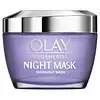What's inside
What's inside
 Key Ingredients
Key Ingredients

 Benefits
Benefits

 Concerns
Concerns

 Ingredients Side-by-side
Ingredients Side-by-side

Water
Skin ConditioningGlyceryl Stearate
EmollientPropanediol
SolventC12-15 Alkyl Benzoate
AntimicrobialGlycerin
HumectantIsopropyl Palmitate
EmollientUndecane
EmollientButyrospermum Parkii Butter
Skin ConditioningCaprylic/Capric Triglyceride
MaskingCetyl Alcohol
EmollientDimethicone
EmollientPEG-100 Stearate
Palmitoyl Dipeptide-5 Diaminobutyroyl Hydroxythreonine
Skin ConditioningPalmitoyl Tripeptide-1
Skin ConditioningPalmitoyl Tripeptide-5
Skin ConditioningPalmitoyl Tetrapeptide-7
Skin ConditioningTrifluoroacetyl Tripeptide-2
Skin ConditioningTetradecyl Aminobutyroylvalylaminobutyric Urea Trifluoroacetate
Skin ConditioningCeramide NP
Skin ConditioningCeramide AP
Skin ConditioningCeramide EOP
Skin ConditioningPhytosphingosine
Skin ConditioningCholesterol
EmollientTridecane
PerfumingAllantoin
Skin ConditioningTocopherol
AntioxidantGlycol Distearate
EmollientPotassium Cetyl Phosphate
EmulsifyingButylene Glycol
HumectantEthylhexylglycerin
Skin ConditioningAcrylates/C10-30 Alkyl Acrylate Crosspolymer
Emulsion StabilisingCarbomer
Emulsion StabilisingPolysorbate 20
EmulsifyingDextran
Magnesium Chloride
Phenoxyethanol
PreservativeDisodium EDTA
Sodium Hydroxide
BufferingSodium Lauroyl Lactylate
EmulsifyingXanthan Gum
EmulsifyingWater, Glyceryl Stearate, Propanediol, C12-15 Alkyl Benzoate, Glycerin, Isopropyl Palmitate, Undecane, Butyrospermum Parkii Butter, Caprylic/Capric Triglyceride, Cetyl Alcohol, Dimethicone, PEG-100 Stearate, Palmitoyl Dipeptide-5 Diaminobutyroyl Hydroxythreonine, Palmitoyl Tripeptide-1, Palmitoyl Tripeptide-5, Palmitoyl Tetrapeptide-7, Trifluoroacetyl Tripeptide-2, Tetradecyl Aminobutyroylvalylaminobutyric Urea Trifluoroacetate, Ceramide NP, Ceramide AP, Ceramide EOP, Phytosphingosine, Cholesterol, Tridecane, Allantoin, Tocopherol, Glycol Distearate, Potassium Cetyl Phosphate, Butylene Glycol, Ethylhexylglycerin, Acrylates/C10-30 Alkyl Acrylate Crosspolymer, Carbomer, Polysorbate 20, Dextran, Magnesium Chloride, Phenoxyethanol, Disodium EDTA, Sodium Hydroxide, Sodium Lauroyl Lactylate, Xanthan Gum
Water
Skin ConditioningDimethicone
EmollientGlycerin
HumectantNiacinamide
SmoothingPEG-Crosspolymer
Polymethylsilsesquioxane
Polyacrylamide
Polyethylene
AbrasivePanthenol
Skin ConditioningPalmitoyl Pentapeptide-4
Skin ConditioningTocopheryl Acetate
AntioxidantCamellia Sinensis Extract
AntioxidantAllantoin
Skin ConditioningButoxyethanol
MaskingDimethiconol
EmollientLaureth-4
EmulsifyingLaureth-7
EmulsifyingSodium PEG-7 Olive Oil Carboxylate
EmulsifyingPEG-30 Dipolyhydroxystearate
EmulsifyingTrideceth-6
EmulsifyingDisodium EDTA
Acrylates/C10-30 Alkyl Acrylate Crosspolymer
Emulsion StabilisingAminomethyl Propanol
BufferingPEG-100 Stearate
Ammonium Polyacrylate
StabilisingTitanium Dioxide
Cosmetic ColorantC13-14 Alkane
SolventDMDM Hydantoin
PreservativeBenzyl Alcohol
PerfumingIodopropynyl Butylcarbamate
PreservativeMethylparaben
PreservativePropylparaben
PreservativeParfum
MaskingCaramel
Cosmetic ColorantWater, Dimethicone, Glycerin, Niacinamide, PEG-Crosspolymer, Polymethylsilsesquioxane, Polyacrylamide, Polyethylene, Panthenol, Palmitoyl Pentapeptide-4, Tocopheryl Acetate, Camellia Sinensis Extract, Allantoin, Butoxyethanol, Dimethiconol, Laureth-4, Laureth-7, Sodium PEG-7 Olive Oil Carboxylate, PEG-30 Dipolyhydroxystearate, Trideceth-6, Disodium EDTA, Acrylates/C10-30 Alkyl Acrylate Crosspolymer, Aminomethyl Propanol, PEG-100 Stearate, Ammonium Polyacrylate, Titanium Dioxide, C13-14 Alkane, DMDM Hydantoin, Benzyl Alcohol, Iodopropynyl Butylcarbamate, Methylparaben, Propylparaben, Parfum, Caramel
Ingredients Explained
These ingredients are found in both products.
Ingredients higher up in an ingredient list are typically present in a larger amount.
Acrylates/C10-30 Alkyl Acrylate Crosspolymer is a synthetic polymer. It is used to thicken and improve the texture of products. Due to its properties, it can prevent water and oil ingredients from separating.
Allantoin is a soothing ingredient known for its protective and moisturizingg properties. Because of this, it is often added to products with strong active ingredients.
Studies show higher concentrations of this ingredient can promote wound healing.
Though it can be derived from the comfrey plant, allantoin is produced synthetically for cosmetic products to ensure purity.
Learn more about AllantoinDimethicone is a type of synthetic silicone created from natural materials such as quartz.
What it does:
Dimethicone comes in different viscosities:
Depending on the viscosity, dimethicone has different properties.
Ingredients lists don't always show which type is used, so we recommend reaching out to the brand if you have questions about the viscosity.
This ingredient is unlikely to cause irritation because it does not get absorbed into skin. However, people with silicone allergies should be careful about using this ingredient.
Note: Dimethicone may contribute to pilling. This is because it is not oil or water soluble, so pilling may occur when layered with products. When mixed with heavy oils in a formula, the outcome is also quite greasy.
Learn more about DimethiconeDisodium EDTA plays a role in making products more stable by aiding other preservatives.
It is a chelating agent, meaning it neutralizes metal ions that may be found in a product.
Disodium EDTA is a salt of edetic acid and is found to be safe in cosmetic ingredients.
Learn more about Disodium EDTAGlycerin is already naturally found in your skin. It helps moisturize and protect your skin.
A study from 2016 found glycerin to be more effective as a humectant than AHAs and hyaluronic acid.
As a humectant, it helps the skin stay hydrated by pulling moisture to your skin. The low molecular weight of glycerin allows it to pull moisture into the deeper layers of your skin.
Hydrated skin improves your skin barrier; Your skin barrier helps protect against irritants and bacteria.
Glycerin has also been found to have antimicrobial and antiviral properties. Due to these properties, glycerin is often used in wound and burn treatments.
In cosmetics, glycerin is usually derived from plants such as soybean or palm. However, it can also be sourced from animals, such as tallow or animal fat.
This ingredient is organic, colorless, odorless, and non-toxic.
Glycerin is the name for this ingredient in American English. British English uses Glycerol/Glycerine.
Learn more about GlycerinPeg-100 Stearate is an emollient and emulsifier. As an emollient, it helps keep skin soft by trapping moisture in. On the other hand, emulsifiers help prevent oil and water from separating in a product.
PEGS are a hydrophilic polyether compound . There are 100 ethylene oxide monomers in Peg-100 Stearate. Peg-100 Stearate is polyethylene glycol ester of stearic acid.
Water. It's the most common cosmetic ingredient of all. You'll usually see it at the top of ingredient lists, meaning that it makes up the largest part of the product.
So why is it so popular? Water most often acts as a solvent - this means that it helps dissolve other ingredients into the formulation.
You'll also recognize water as that liquid we all need to stay alive. If you see this, drink a glass of water. Stay hydrated!
Learn more about Water